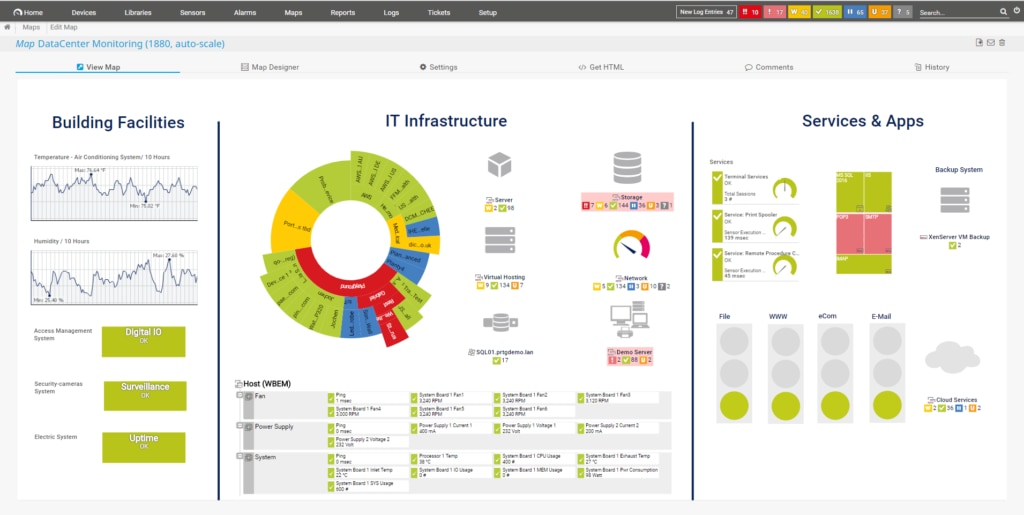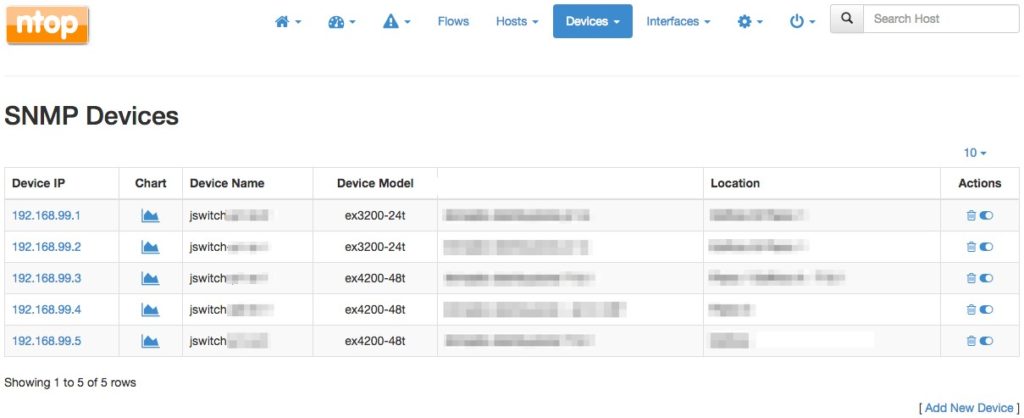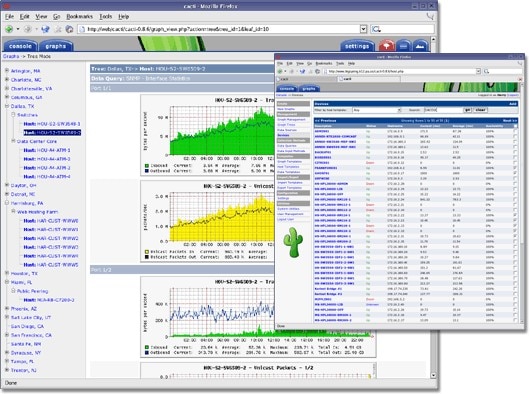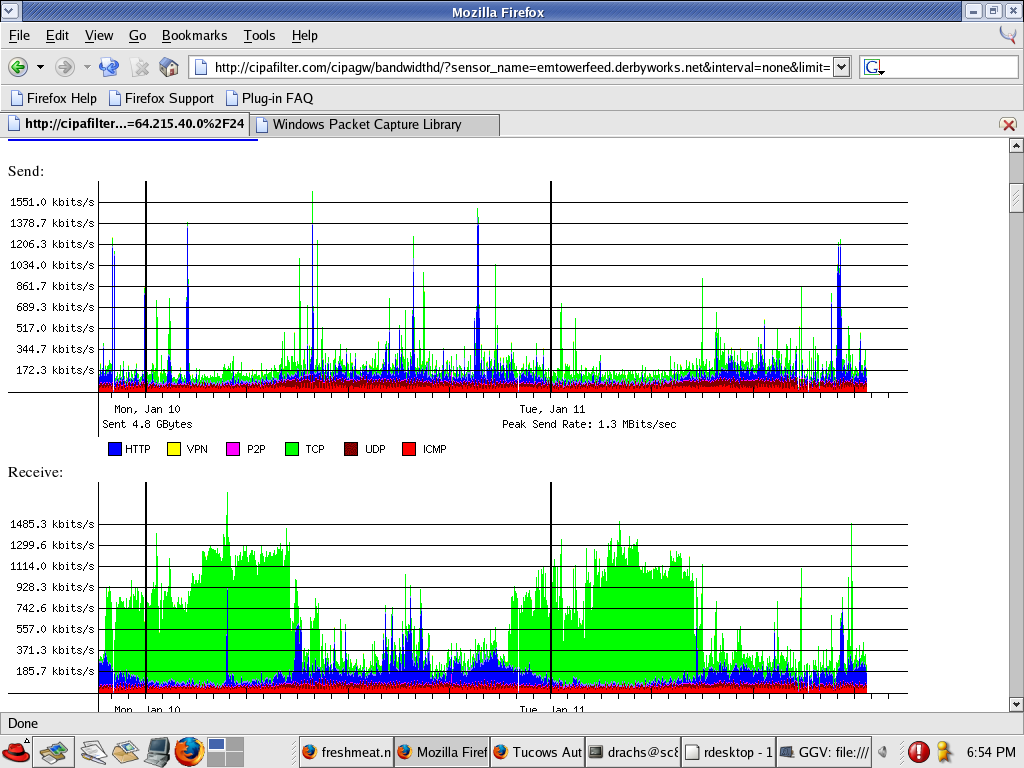We’ve all been there—end users are complaining about slow internet, but you thought you had plenty of bandwidth. Over the years, I’ve come to realize you probably do, in most cases. In fact, throwing additional bandwidth at the issue is often an expensive Band-Aid. What you need is to get to the root of performance problems.
Why Are Network Bandwidth Monitoring Tools Important?
How Do Bandwidth Monitors Work?
How to Choose the Best Network Bandwidth Monitor?
9 Best Bandwidth Monitors in 2023
1. SolarWinds NetFlow Traffic Analyzer (Free Trial)
2. SolarWinds Observability Self-Hosted (FreeTrial)
3. PRTG Network Monitor
4. SolarWinds Network Performance Monitor (Free Trial)
5. ManageEngine NetFlow Analyzer
6. Datadog Network Performance Monitoring
7. ntopng
8. Cacti
9. BandwidthD
If you want to see what’s using your bandwidth or check the bandwidth of your server, you can benefit from implementing a bandwidth monitoring tool. There are several options on the market, varying from the rudimentary to the more analytical. Some are free, and some come with a price tag. What matters is finding the right fit for your business.
My overall favorite? SolarWinds Observability Self-Hosted. This comprehensive tool allows users to monitor bandwidth as well as identify, diagnose, and resolve network performance issues with ease via its highly intuitive dashboard. The best part? You can try it out by downloading a 30-day, fully functional free trial.
What Is Network Bandwidth Monitoring?
To understand network bandwidth monitoring, it’s important to take a few steps back and paint the full picture of bandwidth usage in general. Bandwidth refers to a network’s capacity to transfer data between devices or the internet within a given span of time. Higher bandwidth allows data to be transferred at a faster rate and for more devices to connect at once.
I like to refer to networks as highways and bandwidth as the lanes. The more lanes you have on a highway, the more easily traffic can move. The same thing is true of a network. If too many users are watching videos or downloading files—any type of high-data activity—your network speed will lag. This is why you may often notice a slower connection in public places full of users, with their laptops open and tablets in hand, all trying to use the internet at once.
Bandwidth capacity is typically determined by the connection type. Digital subscriber line (DSL) internet relies on telephone lines and has limited capabilities. Cable internet is faster, but fiber-optic speeds trump them all. The exact amount and type of bandwidth your company needs depend on the size of the business, but it’s safe to assume any operation brimming with laptops, phones, tablets, and other devices should be equipped with substantial bandwidth capacity if they want to provide a fast and efficient experience for all end users.
9 Best Bandwidth Monitors List >>>
Why Is Network Bandwidth Monitoring Important?
Typically, it takes a network interruption to alert IT technicians to a problem. At that point, they are forced to be reactive rather than proactive. But if you always have your finger on the pulse of the network, you have a distinct advantage—you can spot and address issues more quickly because you know where to look.
This is where network bandwidth monitoring comes into play. With the right network bandwidth monitoring tool, you can:
- Identify bandwidth needs. While servers can be reconfigured if needed, it’s best to calculate your company’s bandwidth requirements at the start to avoid major overhauls down the line. This means determining the bandwidth needs of your enterprise’s local area network (LAN) or wide area network (WAN). A network usage monitor will allow you to monitor WAN bandwidth and LAN bandwidth, glean a comprehensive understanding of the bandwidth capacity your network requires, and better evaluate when it may be time to upgrade your bandwidth—for example, if your company converts to laptops from PCs or adds a new division of employees. When you’re monitoring network performance on an ongoing basis, you’re better prepared to spot trends indicating a need for greater bandwidth far in advance. Put simply, planning for an upgrade should never take place as the result of a crisis.
- Boost network performance. The solutions to bandwidth complaints are often obvious, once you know where to look. Bandwidth analyzers provide a complete picture of your bandwidth and network health, empowering you to identify the applications using the most bandwidth and how they’re being used, spot bottlenecks at a glance, analyze and monitor traffic patterns, track response time, availability, and uptime of routers, switches, and other SNMP-enabled devices, and drill down into all of these details as needed. This allows you to be proactive about spotting emerging problems and quickly get to the root of a performance issue before end users complain and productivity comes to a grinding halt.
- Save your budget. While it’s sometimes necessary to add bandwidth, it can be an expensive undertaking. Before you put extra spend behind your bandwidth, I always recommend leveraging a bandwidth monitoring tool to gather and communicate both granular and big-picture network usage information. Monitoring allows you to head off issues and troubleshoot slowdowns without the added investment in more bandwidth.
- Enhance security. Hackers are abounding, ready to jump on an opportunity to inject malware into your company’s system and prey on highly sensitive data and information. Monitoring bandwidth usage will enable you to readily identify suspicious activity and hosts by providing a detailed snapshot of potentially malicious traffic flows. Armed with this level of insight, you can stop hackers in their tracks and protect your company from a data breach.
How Do Bandwidth Monitors Work?
The working principle of bandwidth monitors is to capture and analyze network traffic data to identify network trends, patterns, and anomalies. Additionally, they provide real-time statistical metrics on various aspects of network performance, such as bandwidth usage, network availability, packet loss, congestion, latency, and throughput.
There are two main ways that bandwidth monitors collect and monitor data:
1. SNMP (Simple Network Management Protocol)
SNMP is a widely used protocol for monitoring and managing network devices. Bandwidth monitors employing SNMP can query network devices like routers and switches to gather performance and traffic statistics.
SNMP-enabled devices store information in Management Information Bases (MIBs), which the monitor retrieves through periodic queries. The collected data, including bandwidth utilization and interface statistics, is then analyzed to provide insights into network traffic and performance.
2. NetFlow
NetFlow is a protocol developed by Cisco Systems that captures and exports flow data from network devices. A flow represents a unidirectional sequence of packets with shared characteristics. Bandwidth monitors using NetFlow receive and analyze exported flow records containing details such as source/destination IP addresses, ports, protocols, and timestamps. This data enables the calculation of metrics like bandwidth utilization, top talkers, and traffic patterns, facilitating efficient capacity planning and troubleshooting.
How to Choose the Best Network Bandwidth Monitor?
There are many different network bandwidth monitors available in the market, so it can be difficult to choose the best one for your needs. Here are a few factors to consider when choosing a bandwidth monitor:
| Network Size and Complexity | If you have a large and complex network, choose a bandwidth monitor that can handle a high volume of network traffic and has advanced analytics and filtering capabilities to help you pinpoint and isolate issues quickly. |
| Scalability | It’s important to choose a bandwidth monitor that can grow with your network. Ideally, choose a monitor that can scale up to accommodate your increasing traffic and feature needs. |
| Ease of Use | Choose a bandwidth monitor that’s easy to navigate and provides a simple user interface, as this will help your team quickly and accurately analyze and take action based on network statistics. |
| Reporting and Alerting | Choose a bandwidth monitor that has robust reporting and alerting capabilities. A good bandwidth monitor will provide graphical representations and customizable reports to reflect network performance and usage statistics. |
| Cost | Finally, consider the cost of the bandwidth monitor and ensure that it fits within your budget constraints. Consider the long-term cost of ownership in terms of functionality, support, and scalability. |
9 Best Bandwidth Monitors in 2023
A wide variety of network traffic monitoring tools and bandwidth monitors are on the market. Some are more robust and comprehensive in their service offerings, while others are lean. Some involve a fair amount of spend, and others are free or open-source. Finding the right fit for your business boils down to the level of monitoring you hope to achieve and what your company’s budget (or lack thereof) will allow. Here are my picks for the top 9 tools to monitor bandwidth and network usage:
1. SolarWinds Observability Self-Hosted (FreeTrial)

SolarWinds Observability Self-Hosted is a comprehensive solution designed to increase visibility, intelligence, and productivity across on-premises and multi-cloud environments. This robust tool contains all the features of Network Performance Monitor and NetFlow Traffic Analyzer, providing highly advanced bandwidth monitoring capabilities. It’s a reliable solution for detecting, diagnosing, and preventing network performance issues. It integrates data from various IT ecosystem components, including networks, servers, applications, databases, and more, offering full-stack observability. The goal is to help organizations ensure availability, reduce remediation time, and gain valuable insights into their hybrid cloud infrastructure.
The SolarWinds solution encompasses various features, such as cloud infrastructure monitoring, enabling organizations to monitor and optimize performance and cost in their cloud environments. It also includes application performance monitoring, providing in-depth insights into application performance across multiple environments. Synthetic monitoring is another aspect, enabling organizations to simulate user interactions and proactively identify issues before they affect users. Furthermore, SolarWinds Observability Self-Hosted offers log monitoring, facilitating centralized log management and analysis for faster issue detection and resolution.
Key Features:
- Infrastructure, network, and application performance observability
- Historical and real-time dashboards
- Intelligent AIOps correlation, alerting, and customizable reporting
- Automated discovery and dependency mapping
- Configuration management for networks, virtualization, servers, and applications
2. SolarWinds NetFlow Traffic Analyzer (Free Trial)

SolarWinds® NetFlow Traffic Analyzer (NTA) it’s a comprehensive network bandwidth monitor that can be leveraged to monitor network traffic across a wide variety of vendors and devices, including Cisco, Juniper, and Extreme Networks routers, switches, and firewalls.
If you’re looking for an in-depth, single-vendor network architecture bandwidth analyzer, NetFlow Traffic Analyzer is for you. The platform features the visual correlation I love, complete with the drag-and-drop network performance analysis dashboard so you can drill into any network element and analyze traffic patterns over minutes, days, or months.
With SolarWinds NetFlow Traffic Analyzer, you can quickly identify bandwidth use by application, protocol, and IP address group to see where bandwidth is being sapped. This level of analysis, paired with customizable network traffic reports displaying historical data and identifying peak bandwidth usage, empowers you to adjust policies for better bandwidth management and avoid spending extra on additional bandwidth.
Beyond these features, if your business regularly uses cloud-based applications, like VoIP or e-commerce systems, the software can also be leveraged to verify prioritized traffic moves smoothly through the network. This is an essential part of CBQoS policy optimization.
Key Features:
- Advanced reporting and visualization
- Supports NetFlow, sFlow, J-Flow, IPFIX, and NetStream
- Network traffic alerting and notification
- Performance analysis dashboard
3. PRTG Network Monitor

PRTG Network Monitor from Paessler is a comprehensive yet strikingly simple tool for monitoring your entire IT infrastructure. This internet usage monitoring software allows you to measure all the traffic in your network by monitoring the data directly on your routers. PRTG Network Monitor also helps you determine how much bandwidth your devices and applications are using and monitor heavy overloads, so you can quickly and accurately pinpoint bottlenecks. Depending on your network and hardware, you can use different protocols, like SNMP, flow, or packet sniffing, to leverage the tool and determine who or what is using your bandwidth. Once you’ve identified the root of the problem, you can act swiftly, putting new bandwidth usage management policies in place without having to put additional spend behind greater bandwidth.
This all-in-one solution goes beyond bandwidth analysis and monitors SQL, Exchange, and server software as well as all your cloud and virtualization applications, making it an elaborately in-depth service offering. You can even use the tool as a network speed monitor.
The Windows-based PRTG tool comes in two editions: a free version for monitoring up to 100 sensors and a commercial edition for those who need to monitor a greater number of sensors. But depending on the volume of sensors you need to monitor, the software can quickly become a drain on your budget.
Key Features:
- Highly customizable reporting
- Identifies bandwidth hogs
- Automatic network discovery
- Outstanding usability
4. SolarWinds Network Performance Monitor (Free Trial)

SolarWinds® Network Performance Monitor (NPM) is a robust and comprehensive bandwidth monitoring tool designed to provide organizations with deep insights into their network performance. With its advanced features and intuitive interface, NPM allows network administrators to effectively monitor and manage bandwidth usage, ensuring optimal network performance.
SolarWinds NPM enables monitoring of all components of a network, allowing early problem identification and ensuring maximum uptime. It also offers features like NetFlow Traffic Analyzer (NTA), which helps enhance and simplify the traffic monitoring process. With SolarWinds Network Performance Monitor, you can view bandwidth usage by application, protocol, and IP address group.
Key Features:
- NetPath™ and PerfStack™ for easy troubleshooting
- Network Insights™ for deeper visibility
- Intelligent maps for automated network discovery
- Smarter scalability for large environments
5. ManageEngine NetFlow Analyzer

ManageEngine NetFlow Analyzer bills itself as a complete traffic analytics tool, and for good reason. The platform leverages flow technologies, including NetFlow, sFLow, IPFIX, NetStream, J-Flow, and Appflow, to provide real-time visibility into network bandwidth performance. Once you can access analytics, you can classify applications hogging your network bandwidth and even reconfigure your policies via application-level QoS shaping, helping you regain control over those bandwidth-hungry applications.
With real-time insights and detailed analytics letting you drill down and discover traffic patterns and device performance, as well as historical bandwidth reports, you’ll have the information you need for more informed capacity planning. You’ll know when it’s time to grow your bandwidth, and when it’s best to implement a new policy or shut down a specific device.
The security features of this bandwidth monitoring tool are also worth noting. NetFlow Analyzer’s Continuous Stream Mining Engine helps you detect external and internal threats, track network anomalies, and identify zero-day intrusions, so you can jump into action when needed.
Key Features:
- Application-specific usage monitoring
- Security and anomaly detection
- Network configuration management
- Monitors bandwidth, volume utilization, speed, packets transferred and exports reports.
6. Datadog Network Performance Monitoring

Datadog Network Performance Monitoring is a powerful cloud-based SaaS service designed to monitor and analyze network traffic flows. With its live network mapping and protocol analysis capabilities, it offers organizations valuable insights into their network performance. By continuously monitoring traffic volumes and analyzing data at each device, it enables users to identify bottlenecks, track application performance, and optimize network resources.
One of the standout features of Datadog Network Performance Monitoring is its ability to generate real-time visual representations of network activity. Through its Flow Analytics feature, users can view traffic flows on each stretch of the network and gain a detailed understanding of traffic volumes by clicking on specific devices. This visual data representation simplifies the comprehension of network activity, making it easier to identify patterns, anomalies, and areas of improvement.
Key Features:
- Performance alerts
- Internet connection analysis
- Network traffic volume monitoring
7. ntopng

Formerly called ntop, ntopng (“ng” is for “next generation”) is a simple, to-the-point traffic probe that uses libpcap, a tool for packet capture, to report on network traffic and usage. The platform allows users to sort network traffic according to a wide range of criteria, including IP address, port, L7 protocol, autonomous systems, and more. Ntopng displays network traffic and active hosts in real time, so you can stay up to date while producing historical reports to review data and better identify trends. Although this reporting capability isn’t as robust as some of the other products I’ve discussed, it does a fair job and can track data such as application protocols and throughput.
Ntopng has a commercial version called ntopng pro with some additional bells and whistles, but the open-source version is good enough to quickly gain insight into traffic behavior. It can also integrate with external monitoring applications such as Nagios for alerting and provide data for monitoring.
Key Features:
- Deep packet inspection
- Focused on traffic visibility and cybersecurity
- SNMP v1/v2c/v3 support and continuous monitoring of SNMP devices
- Traffic flow statistics
8. Cacti

Cacti is mainly an open-source, front-end graphing tool for system data, but it can also handle data collection. The software leverages RRDTool, a data logging and graphing system, so you can collect data from almost any infrastructure element, including load balancers and servers, routers and switching systems, firewalls, and so on, and display it in different graphical formats.
Cacti also supports SNMP polling, which itself covers a wide range of network devices. This feature allows you to monitor bandwidth usage by graphing it on an interface. The simple yet powerful line graphs Cacti produces can show spikes and dips in traffic, but they don’t offer the thorough performance analysis of the graphs and charts featured in many of the paid options listed here. This is a smart, free option for those who want a high-level view of their bandwidth. It can be installed on either Unix or Windows OS.
Key Features:
- Vast plugin ecosystem to extend the core functionality of Cacti
- Device, automation, and graph templating
- Distributed data collection uses remote data collectors, which are resilient to intermittent network failures
- Automated device discovery, including graph and tree automation
9. BandwidthD

BandwidthD is a free, starkly simple tool for bandwidth monitoring. While the program hasn’t been updated since 2013, it still maintains a steady stream of network and traffic data by tracking usage of TCP/IP network subnets and building HTML files, complete with graphs to display utilization. When launching the platform, you may find it a little finicky—you’ll need a relatively sound knowledge base for setting up manual configurations. But it’s effective if all you’re looking for is a no-cost, straightforward solution.
BandwidthD runs on most platforms, including Windows. Just remember it requires winpcap or libpcap for Linux and Unix users.
Key Features:
- Lightweight and open source
- Real-time and historical data analysis
- Threshold-based alerts
Top Tool for Bandwidth Monitoring
Regardless of size or budget, all companies should implement bandwidth monitoring. Monitoring your bandwidth will help you boost network performance, identify bandwidth needs, potentially save your business money, and add an extra layer of security to your everyday activities. With the right tool, you’ll be empowered to quickly identify performance issues and even stop them in their tracks before they bring end-user productivity to a standstill.
While there are a number of good bandwidth monitoring tools on the market, my favorite is by far SolarWinds Hybrid Cloud Observability. This robust offering makes it easy to drill down into the data and analyze your applications and bandwidth traffic via a clear, intuitive web-based dashboard. It’s well worth the investment and could save your company from having to invest in additional bandwidth. If you’re still unsure, I recommend downloading the Free, 30-day trial version and experiencing its benefits firsthand.
Recommended Reading
Ultimate Guide to Network Monitoring – If you’re looking for comprehensive information on how to monitor and take care of your network, I’ve put together a beginner’s guide followed by more expert-level instructions covering everything you need to know.
This post was written by Israel Oyetunji. Israel is a frontend developer with a knack for creating engaging UI and interactive experiences. He has proven experience developing consumer-focused websites using HTML, CSS, Javascript, React JS, SASS, and relevant technologies. He loves writing about tech and creating how-to tutorials for developers.




